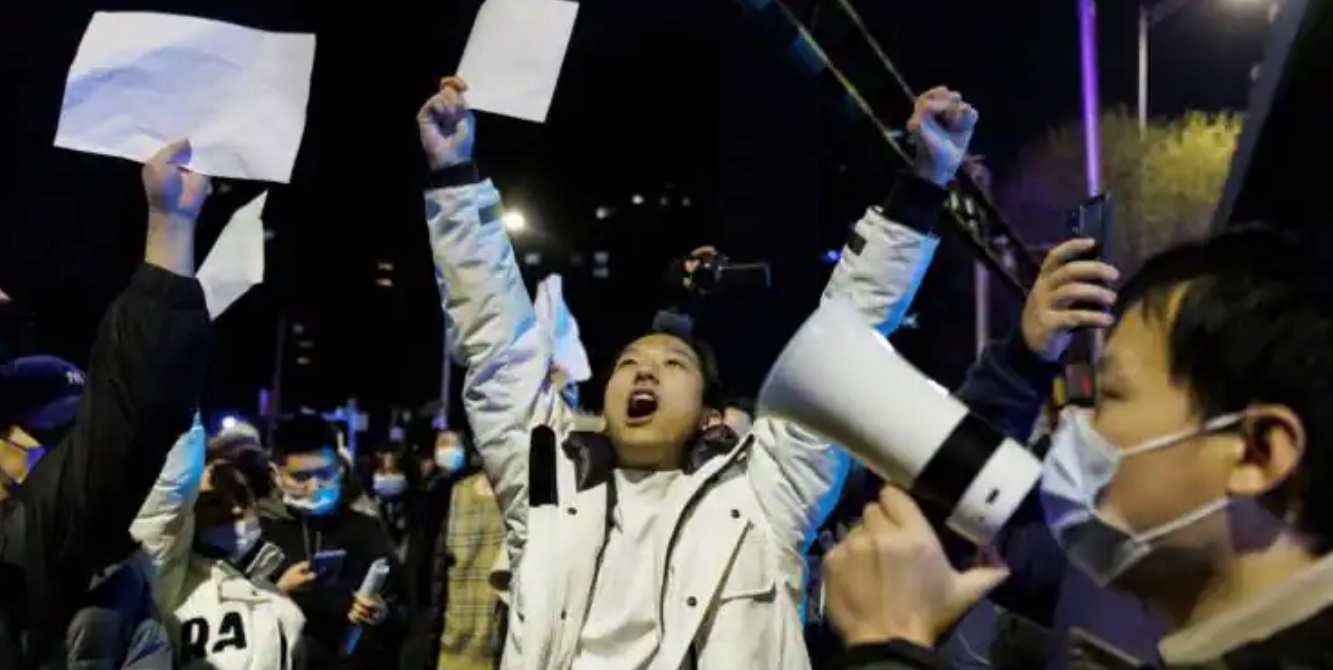
Mass protest in China against Jinping regime
Recent happenings in neighboring China remind us of the old saying, “those who dig a pit for others, God digs a moat for them. The coronavirus that the ‘dragon’ unsolicitedly gifted to the world has returned as a return gift of sorts to haunt it. The Chinese people’s patience is running thin as President Xi Jinping’s regime remains unrelenting in forcing snap lockdowns and rigorous quarantine of entire cities as part of its zero Covid policy.
All leading global media outlets have reported unprecedented protests across many Chinese cities in the last week of November 2022. Videos of hundreds of workers facing off with law enforcement officers at the world’s largest iPhone factory in Zhengzhou city went viral. A Covid outbreak a few days earlier had led the local authorities to lock down this Foxconn campus. Then came the deadly fire incident at an apartment building in Urumqi, the capital of the restive Xinjiang province. Many people suspected that a Covid lockdown might have trapped many victims inside their homes and slowed down rescue efforts, leading to the failure to save at least 10 lives. Rare protests erupted against Xi Jinping’s regime in Xinjiang and the country’s capital of Beijing.
These are just a few instances of rising anger among the Chinese populace. Reports suggest public protests were taking place in at least a dozen Chinese cities at the time of writing this article. The people are openly defying lockdowns and refusing to give samples for mass testing. Barricades were also purportedly broken in some places.
This surge of public outrage has surprised the world as the ruling Communist Party is known for its sweeping control over dissent and the general population was also believed to be used to authoritarianism, more so during the pandemic. Forced mass quarantines are common in China. Entire localities, sometimes even cities, are abruptly closed down for weeks after the detection of even a few Covid cases. This at a time when the Chinese government has proven itself to be almost entirely opaque in presenting the true picture of the pandemic to the world. Many analysts have accused the Chinese government of underplaying actual Covid-19 statistics. The Communist Party leaders have sought to assuage the public sentiment by claiming their commitment to saving lives. They have pointed towards over a million Covid-19 deaths in the US to ask for people’s patience. Nevertheless, the public seems to be in no mood to take any more of the zero Covid policy.
Meanwhile, the Chinese economy continues to pay the price for it. Most factories in the world’s manufacturing hub are struggling with supply chain constraints aggravated by unpredictable lockdowns and other stringent measures and the impact on their workers has been debilitating. The Chinese economy has shown a meager 0.4 per cent growth in this year’s third fiscal quarter as compared to the previous one although the Chinese spin doctors are highlighting the comparison with the same quarter in the previous year that shows a recovery of 3.9 per cent. However, both numbers are disappointing by China’s own standards.
Many analysts are predicting worse days ahead for the Chinese economy if the Xi Jinping regime persists with the current path. Not that the Chinese policymakers are oblivious to the situation. The Chinese cabinet had actually relaxed the current Covid-19 protocol in the second week of November. The move backfired unfortunately as the country saw a record surge in Covid-19 cases and daily cases breached the 40,000 mark.
All these facts suggest the ‘dragon’ is now stuck between the devil and the deep sea. Persisting with the same course means pushing the economy towards an even greater debacle and further fueling public outrage. Backtracking and accepting the Covid-19 virus as a fact of life would amount to an admission of past mistakes, something all totalitarian regimes hate. It might weaken President Xi Jinping’s complete grip on power.
Like every dictator, this is a conundrum that President Xi would also not like- admitting a failure or continuing with the mistake. We have already seen slogans directly naming him being raised openly by protestors.
We need to understand these signals more deeply. It seems the current resentment runs deeper than just the Covid-19 fatigue. The ongoing situation may well be symptomatic of the public sentiment against the Communist one-party rule, or even more significantly of the urge for freedom from President Xi’s vanity of holding on to power for a lifetime.
Even the mention of the 1989 Tiananmen Square pro-democracy protest and the massacre that followed is forbidden in China. It seems to be changing in the current wave of protests. This is just one sign showing you how all is not well in China.
To make matters worse, the Chinese government is not known for its propensity to solve matters through dialogue. It has always been used to get its way through coercion. The entire world was aghast at how the Shanghai police unabashedly sprayed black pepper spray to disperse the protestors. It was another evidence of the continued repression of the Chinese people even as the rest of the world is moving towards more democracy.
Our other most significant neighbor Pakistan is grappling with its own share of problems. Its economy is like a chronic ICU patient and shows hardly any sign of recovery. Its political realities are convoluted to the point that the real power play is seen between Imran Khan and the army generals even as Shehbaz Sharif remains the Prime Minister.
To make matters worse, Pakistan has to put up with its self-created demons. The dreaded terrorist organization Tehrek-e-Taliban Pakistan (TTP) has ended the fragile ceasefire agreement with the government. The announcement has come right after General Asim Munir has taken the baton from General Qamar Javed Bajwa. Suffice it to say about General Munir’s credentials that the infamous Pulwama attack was perpetrated when he was the ISI chief. His ascension is not seen as favorable to Imran Khan. The US think tank Atlantic Council fears Pakistan could be heading towards a more troubled time in the wake of the current circumstances. It warns of increased internal security challenges and further polarization of Pakistani society, a recipe many would say for a civil war.
India cannot remain indifferent to this turmoil next door. History bears testimony to the fact that an unstable China or a chaotic Pakistan could go to any extent against India. It suits the Chinese regime to rake up tensions against India to divert the attention of its own public. Likewise, Pakistan would most certainly never shy from heating up things in Kashmir to deflect other domestic challenges.
We need to pay attention to the Pentagon’s latest report on Chinese military might. It claims China was not only working to strengthen its nuclear arsenal but also actively helping its key allies like Pakistan on the military front. The report also refers to the continued illegal infrastructure activities undertaken by the People’s Liberation Army (PLA) along the Ladakh border. Beijing had recently called a meeting of 19 Indian Ocean nations, reportedly skipping India an invite. While India is not new to the China-Pakistan nexus, we need to view it in the current context and prepare ourselves to meet the challenge.


















